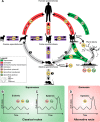Sporothrix Species Causing Outbreaks in Animals and Humans Driven by Animal-Animal Transmission
- PMID: 27415796
- PMCID: PMC4945023
- DOI: 10.1371/journal.ppat.1005638
Sporothrix Species Causing Outbreaks in Animals and Humans Driven by Animal-Animal Transmission
Conflict of interest statement
The authors have declared that no competing interests exist.
Figures


References
-
- Schenck BR. On refractory subcutaneous abscesses caused by a fungus possibly related to the Sporotricha . Bull Johns Hopkins Hosp. 1898;9:286–90.
-
- Lutz A, Splendore A. [On a mycosis observed in men and mice: Contribution to the knowledge of the so-called sporotrichosis]. Revista Médica de São Paulo. 1907;21:443–50.
-
- Zhou X, Rodrigues AM, Feng P, Hoog GS. Global ITS diversity in the Sporothrix schenckii complex. Fungal Divers. 2014;66(1):153–65. 10.1007/s13225-013-0220-2 . - DOI
-
- Orofino-Costa R, de Macedo PM, Bernardes-Engemann AR. Hyperendemia of sporotrichosis in the Brazilian Southeast: Learning from clinics and therapeutics. Curr Fungal Infect Rep. 2015;9(4):220–8. 10.1007/s12281-015-0235-0 - DOI
Publication types
MeSH terms
LinkOut - more resources
Full Text Sources
Other Literature Sources

